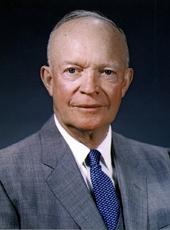
Remarks at the Cornerstone-Laying Ceremony for the Extension of the United States Capitol.
Mr. Speaker, Mr. Stewart, Members of the Commission, Distinguished Guests, and Ladies and Gentlemen:
We are here today for the ceremonial laying of a cornerstone--a ceremony that has twice before marked the history of this building, the Capitol of the United States of America.
By this symbolic gesture we do more than to recognize and provide for the expanding needs of the Congress, resulting from national growth. We rededicate ourselves to the principle of representative government. We reaffirm our devotion to the values upon which this Republic rests.
These values, unequivocally stated in the Declaration of Independence, in our Bill of Rights, and in other parts of that remarkable document, the American Constitution--are both the hallmarks and the hand tools of freedom. In a free society they must be prized and they must be used, lest freedom wither.
In the collision of ideas between freedom and despotism, freedom is neither won nor held in a climate of spiritual stalemate. Its preservation is a many-sided and never-ending task.
Complacency today speeds the erosion of liberty tomorrow. Inertia will destroy it; dynamic dedication assures its lasting vitality.
On this Fourth of July, 183 years since our Nation embarked on its course of independence, we are reminded that our Declaration of Independence did more than galvanize the idea of freedom for our own people.
"The generation that produced our Declaration of Independence," said Lincoln, "meant to set up a standard maxim for free society which should be constantly looked to, constantly proximated, and thereby constantly spreading and deepening its influence and augmenting the happiness and value of life to all people of all colors everywhere."
Now each of these three cornerstone ceremonies has marked stages of America's evolution.
In 1793, when President Washington laid the cornerstone of the original Capitol building, a young but vigorous nation was struggling into political existence.
Fifty-eight years later, when President Fillmore laid the cornerstone of the House and Senate wings, the Nation was no longer in its infancy.
On that day a proud Daniel Webster extolled the progress of the United States since 1793--from 15 States to 31; from 209 Post Offices to 21,000; from 35 colleges to 694--and why it had become necessary to enlarge the Capitol building.
Again this ceremony represents growth. America has come a long way since the laying of the 1851 cornerstone.
Yet it is somehow unnecessary to commemorate this occasion by reminding ourselves of the bare statistics of cultural and material growth.
Rather, we come here today to remind ourselves of our responsibilities-to the world and to ourselves.
We come here to rekindle our faith that this building, the central home of America's representative government, will house wisdom, understanding, and compassion for all people.
Finally, we gather on this Fourth of July--as our forefathers did at Independence Hall--more than 9 score years ago--to emulate them as they pledge their common adherence to basic principles, and their common obligation to uphold these principles regardless of differences of opinion, even of policy.
Today, so long as we never waver in our devotion to the values on which these men began the building of this new nation, no differences of political policy or partisan feeling can cause America to falter on her upward course.
As we now lay this new cornerstone in the United States Capitol, we are grateful for the courageous beginnings of a new nation, represented by the first stone; for the pioneering effort and the bountiful growth represented by the second; and for the confidence that we, if we make ourselves worthy, that this third stone will forever symbolize America's unending purpose, under God, to lead along the path toward peace, with justice for all peoples.
Thank you very much.
Note: The President spoke at 12 noon from a stand erected on the plaza at the east front of the Capitol. His opening words referred to Sam Rayburn, Speaker of the House of Representatives, and J. George Stewart, Architect of the Capitol, both of whom were members of the Commission for the Extension of the United States Capitol. The other members were Vice President Nixon, Senator Dirksen, Minority Leader of the Senate, and Representative Halleck, Minority Leader of the House of Representatives.
Dwight D. Eisenhower, Remarks at the Cornerstone-Laying Ceremony for the Extension of the United States Capitol. Online by Gerhard Peters and John T. Woolley, The American Presidency Project https://www.presidency.ucsb.edu/node/235106

